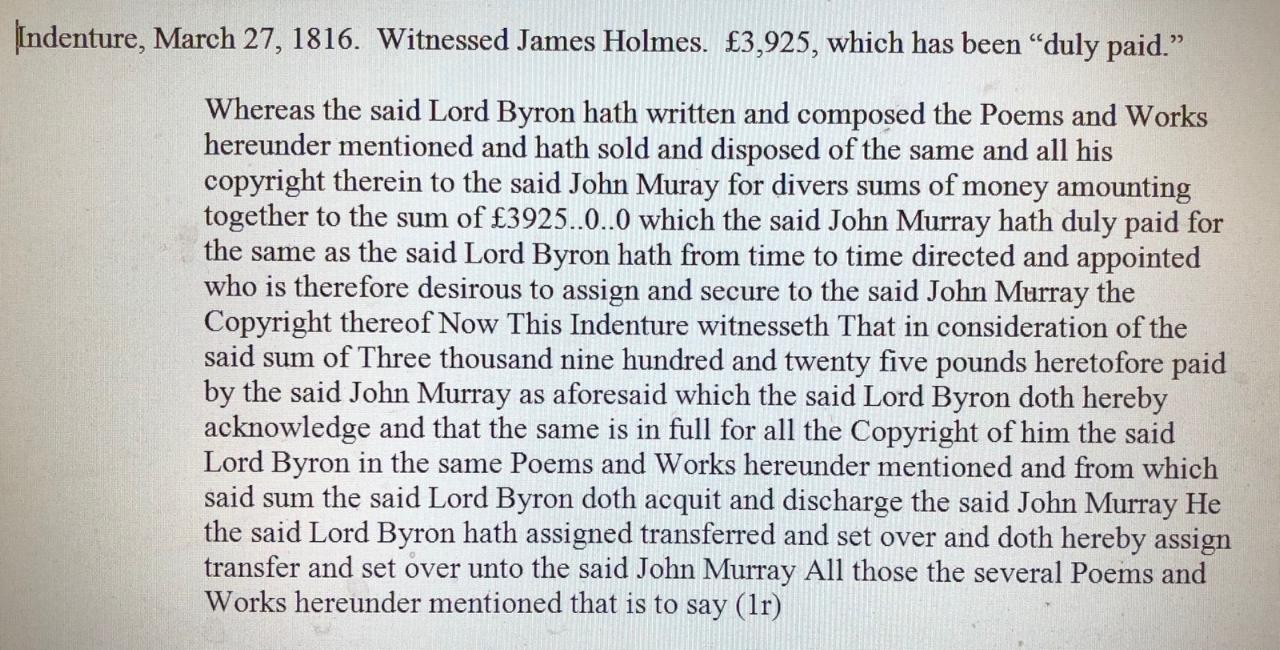Friends, you’re in for a treat.
In this post a couple of days ago, I considered the dual verb structure shall grant and hereby grants, with my IP sensei Ned Barlas guest starring. The next day Ned slipped me the image below, courtesy of Gary Dyer, professor of English at Cleveland State University:
It’s a screenshot of the text of the 1816 indenture between the badass English poet Lord Byron and his publisher, John Murray. (Note that it exhibits that strange bygone drafting fad, omitting all punctuation.) What we care about is the dual verb structure hath assigned transferred and set over and doth hereby assign and transfer and set over.
Gary provided some background:
This indenture was prepared by the well-known solicitor Sharon Turner, who numbered several of the most important London publishers among his clients. The context is that Lord Byron was about to leave for Europe, possibly never to return, and Murray needed to make sure that his title to the various Byron works whose copyrights he had paid for (at various point over the period 1812-1816) was made official. The works involved included such big-selling works as Childe Harold’s Pilgrimage Cantos I-II, The Giaour, and The Corsair.
Gary also said, “Sharon Turner tended to craft documents in such as way as to cover every possibility, so there will be some excess verbiage.” A risk-averse, wordy lawyer? I’m shocked—shocked! (For more background, see Gary’s article Publishers and Lawyers, The Wordsworth Circle 121–26 (2013) (here).)
The dual verb structure is analogous to shall grant and hereby grants, except instead of language of obligation and language of performance, we have language of declaration (a statement of fact) and language of performance. With this verb structure, the issue one faces is the analogous to that raised by shall grant and hereby grants. If you say that Estelle has already left the house and is now leaving the house, only one verb structure can reflect reality.
As with shall grant and hereby grants, the Byron example could be belt-and-suspenders: if for some reason it’s decided that the transfer to John Murray hadn’t already taken place, the transfer effected by the indenture would be the fallback. I see two problems with that. First, if that’s what had been intended, it would have been clearer to say so in separate sentences. And second, traditional contract drafting contains all sorts of nonsense verb structures, so one could explain this dual verb structure as simply more of the same.
Why discuss the Byron example at all? Because it’s alive and well on EDGAR, featuring a variety of verbs:
By executing and delivering this Mortgage, Mortgagor has granted and hereby grants to Mortgagee, as security for the Obligations , a security interest in all of Mortgagor’s right, title and interest in the Mortgaged Property to the full extent that the Mortgaged Property may be subject to the UCC (the portion of the Mortgaged Property so subject to the UCC being referred to in this paragraph as the “Personal Property”).
… the Company has granted, bargained, sold, conveyed, assigned, transferred, mortgaged, pledged, set over and confirmed and hereby grants, bargains, sells, conveys, assigns, transfers, mortgages, pledges, sets over and confirms to the Trustee, and has granted and hereby grants to the Trustee, for itself and for the benefit of the Holders, with power of sale, a lien upon and a security interest in, the following (subject, however, to the terms and conditions set forth in the Mortgage Indenture and herein):
Trustor by executing and delivering this Deed of Trust has granted and hereby grants to Beneficiary, as security for the Debt, a security interest in the Trust Property to the full extent that the Trust Property may be subject to the UCC (such portion of the Trust Property so subject to the UCC being called in this paragraph the “Collateral’ ).
For good and valuable consideration, the receipt and sufficiency of which are hereby acknowledged, Ocular Therapeutix, Inc. (hereinafter referred to as “ASSIGNOR”) has sold, assigned, and transferred, and by these presents hereby sells, assigns, and transfers, unto …
Whatever explanation or lack of explanation one accepts, this dual verb structure is, like other dual verb structures, suboptimal.


I take it as a benign artifact of holiday cheer that you demurely refer to that construction as “suboptimal.” But could the belts-and-suspenders effect not be effectively invoked by saying “has granted, but if not then hereby grants…”? Yes, two sentences would be clearer, but I think even Mark Anderson’s partner Mr. Pettifog would concur that one can be both stodgy and coherent.
Yeah, that could work. And it would no longer be a dual verb structure.
I’m with you, Vance, that two sentences aren’t necessary, but I’m not sure ‘but if not then’ is necessary either. If ‘has granted and hereby grants’ isn’t an obvious (and concise) belt-and-braces locution, what else could it mean? Why isn’t it optimal for its purpose?
In some mortgage foreclosures, accelerating the delinquent loan is a prerequisite to foreclosure, but can be done *in the judicial complaint that starts the foreclosure action*. It is common for the plaintiff to allege that it ‘has accelerated and hereby accelerates’ the note debt. It reduces the plaintiff’s burden of proof without misrepresenting the sequence of events.
So maybe ‘has granted and hereby grants’ is defensible as is. –Wright
On modest further reflection, I think it’s too clipped.